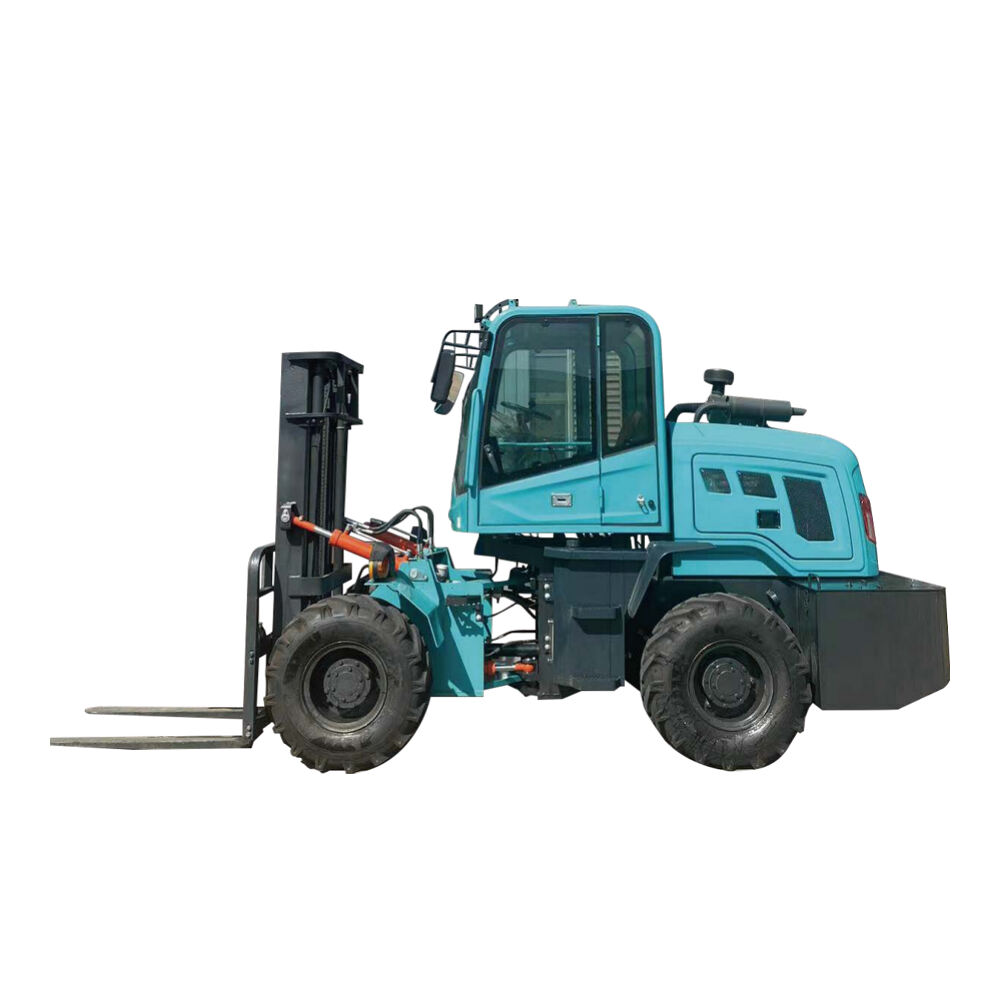Why Crawler Dumpers Outperform Wheeled Models on Rough Terrain
Superior Traction & Stability on Unstable Surfaces
Weight Distribution Advantages of Track Systems
Crawler systems work by spreading out weight across the ground, which reduces pressure points and makes them much steadier on soft terrain. The way these tracked machines spread their load over a bigger area means they're less likely to sink into things like mud, sand, or other unstable ground conditions. Research indicates that tracked vehicles generally stay upright better than regular wheeled ones when facing tough terrain challenges. Look at construction sites with all those bumps and dips, or farms where the ground gets really muddy after rain. That's where tracked equipment truly shines because standard wheels just can't handle the same level of grip needed to avoid getting stuck.
Slope Performance: Crawlers vs Wheeled Counterparts
When it comes to working on slopes, crawler dumpers just perform better than their wheeled counterparts, particularly in rough terrain situations. Their track system spreads out over more ground surface, which gives them much better grip when climbing steep hills. The extra traction makes these machines far more reliable, cutting down on those frustrating slip-ups and safety issues that happen so often with regular trucks trying to negotiate inclines. Industry reports show that standard wheeled equipment gets into trouble much more frequently on hillside jobs because they simply can't maintain proper contact with the earth. Crawlers avoid most of these problems thanks to their inherent stability features that keep them planted firmly even when conditions get tricky.
Terrain-Specific Engineering Advantages
Ground Pressure Comparison in Mud/Sand Conditions
When looking at how machines perform in tough terrain like mud or sand, understanding how pressure spreads across the ground matters a lot. Crawler systems spread out the weight of the vehicle over a bigger surface area than wheels do, which means they put less pressure on the ground below. This makes all the difference in soft spots where regular wheeled equipment tends to get stuck. Take marshy areas for example, crawlers just roll right through while most other vehicles struggle badly. Research from the American Society of Agricultural and Biological Engineers showed something interesting too tracked vehicles cut down ground pressure by around half in some cases. That kind of reduction really helps keep things stable and gives better grip on tricky surfaces. Farmers working their fields after heavy rains and builders tackling projects on sandy sites have both seen firsthand why crawler tech works so well in these situations.
Pivot Steering for Tight Spaces
Tracked vehicles are known for their pivot steering feature, which lets these machines spin on their own axis and move through really tight spots with ease. Compared to regular wheeled equipment, crawlers don't need to back up or go around obstacles when making sharp turns. This makes all the difference on small construction sites or in farm fields packed with crops. As Lee Padgett from the product team explains, this kind of steering allows crawlers to operate efficiently even in places like city building projects where there just isn't enough room to maneuver normally. Most people working in the industry will tell you about how much time pivot steering saves during operations that require pinpoint accuracy. The ability to steer smoothly in cramped conditions gives tracked machines an edge over other types of equipment across many different jobs, especially when dealing with tricky terrain situations that would stop most conventional machinery dead in its tracks.
HT-T30 Rough Terrain Lift Truck Overview
Designed to tackle rough terrain jobs, the HT-T30 lift truck comes packed with a robust 37KW engine paired with a dual speed transmission system. What makes this machine stand out? Well, the combination of engine power and spec sheet numbers delivers steady power delivery right when workers need it most in those harsh job site conditions. Operators get better gas mileage too, which means fewer trips to the fuel station even when bouncing around on uneven ground. The dual speed transmission really shines here, letting drivers shift effortlessly between high and low gears depending on what they're facing at the moment. Need to climb a steep incline? Low gear kicks in with plenty of torque. Moving heavy materials across level surfaces? High gear takes over for smooth operation. This kind of flexibility keeps productivity going strong no matter what challenges come their way.
The HT-T30 comes equipped with tough 20.5/70-16 tires that really make a difference when driving off road. Built to last, these tires stand up well against wear and tear while resisting punctures something anyone who drives on rough ground knows is super important. What makes them work so well? The design includes special features that boost traction, which means fewer flats and less damage when going over rocky or uneven terrain. We're not just talking numbers here either. Field tests and actual feedback from people using these tires day in and day out confirm they hold up in tough situations. Operators report being able to keep running operations smoothly even when conditions get pretty rough, which saves time and money in the long run.
What really sets the HT-T30 apart is its amazing 3000kg load capacity, which plays a big role in making material handling much more efficient on site. With this kind of strength under its belt, operators can move heavy stuff without breaking a sweat, something that makes all the difference for construction crews dealing with steel beams or landscapers hauling around massive rock formations daily. When stacked against other machines in its class, the HT-T30 consistently comes out ahead because of this raw lifting power. Industry reports frequently mention how this feature gives it an edge when tackling big jobs that would strain lesser equipment. The truth is, most work sites aren't designed for delicate operations anyway. The HT-T30 handles whatever gets thrown at it day after day, which explains why so many professionals swear by it as their go-to rugged terrain lift truck.
Operational Synergy With Compact Equipment
Pairing With Mini Excavators for Site Efficiency
When paired together, mini excavators work really well with crawler dumpers to get more done on job sites for construction and landscaping projects. The little excavators handle all those detailed digging tasks where precision matters, whereas the crawler dumpers tackle the tough job of moving dirt and debris over rough ground. Putting these two machines together streamlines what needs to happen on site so everything runs better from start to finish. Take a typical day on a jobsite: the mini digs out the soil, then the dumper cartes it away, keeping both machines busy without wasting time waiting around. Contractors who've used this setup report noticeable improvements in getting things done faster while managing resources smarter. Plus, since these machines aren't huge, they fit into tight spots where bigger equipment would struggle, which makes all the difference when working in city centers or other places where space is at a premium.
Loader Combinations for Heavy Material Transport
When crawler dumpers team up with loaders for moving heavy stuff around, operations get faster and more efficient. Construction sites, demolition zones, and landscaping jobs all see major gains from this setup. The loader does what it does best - grabbing those big loads and dumping them right into the waiting dumper. Then the dumper takes over, trundling across rough ground without breaking a sweat. This kind of workflow really shines when there's tons of debris or dirt needing relocation fast. Contractors report seeing results in their day to day work too. Projects finish quicker because materials move faster between points. Labor bills shrink since fewer workers are needed to handle the same volume. Plus, machines last longer when they're not being pushed beyond their limits constantly. For companies working in tough environments where downtime costs money, getting these two pieces of equipment to work together makes good business sense.
Cost Efficiency in Demanding Environments
Reduced Track Wear vs Wheel Maintenance
Crawler dumpers actually save money in tough conditions because their tracks last longer than the maintenance needed for regular wheeled machines. The way tracks spread out the weight means there's less damage overall, so repair bills stay lower month after month. We've seen plenty of cases where companies spend thousands replacing tires and fixing suspensions on trucks, while tracked equipment just keeps going with minimal fuss. A site manager at a quarry put it this way: "Tracked machines eat up gravel and mud without breaking down every week. They're built for the dirt, not against it." For most contractors working in rocky or muddy areas, switching to tracked systems pays off big time in the long run, especially when looking at annual maintenance budgets.
Long-Term Durability in Rocky Conditions
Built to last in tough terrain, crawler dumpers stand out from the competition when it comes to staying power on rocky sites. Their heavy duty build incorporates thick steel plates and special alloys that help these machines keep running strong where other equipment would break down constantly. Field tests show that crawler models typically last at least twice as long as standard dump trucks in mountainous areas, cutting down on spare parts expenses over time. Engineers design these units with extra reinforcement around stress points, so components don't wear out as fast during daily operations. For companies working in remote mining locations or construction zones with rough ground conditions, investing in crawler dumpers makes financial sense despite the higher upfront cost. These machines just keep going year after year without needing major repairs, making them a smart long term investment for any business dealing with challenging landscapes.


